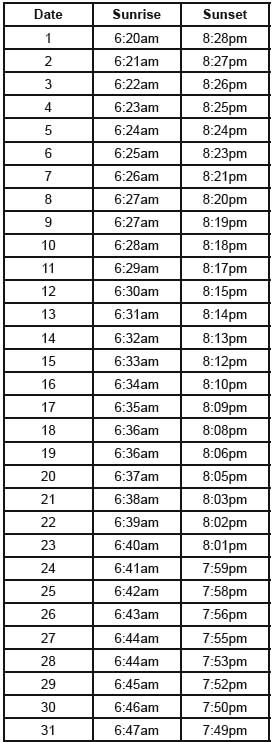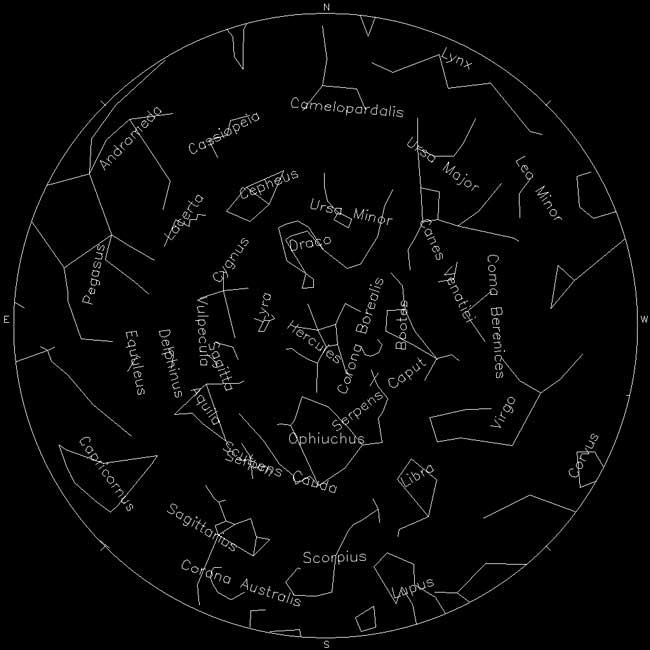Sunrise
and Sunset Times for
August 2008 |
 |
DAYLENGTH
The period of daylight continues to decrease in August, but it is more apparent at the end of the day. As the month progresses, sunrise comes 27 minutes later and sunset 39 minutes earlier. In addition, summer’s extended twilight fades to darkness nearly one hour earlier by the end of the month. Civil twilight lasts about one-half hour after sunset. Nautical twilight continues for another 30-45 minutes with color and shapes still apparent. Astronomical twilight begins when color and detail disappear from the surrounding view. The reverse progression applies to dawn. Sunrise and sunset are calculated for a flat horizon. Actual times may vary depending upon the terrain.
MOON HAPPENINGS
August begins with a new moon. On August 2 and 3 a faint crescent highlights a conjunction of Venus, Saturn, and Regulus in the early evening western sky. A waxing crescent reappears low in the western sky on August 6 near Virgo’s bright star Spica. By August 10 a gibbous moon shares the southern sky with Antares, the bright star of Scorpius. On August 12 the moon rises below Jupiter in the southeastern sky. A full moon rises on August 16 at 8:09pm. After midnight, on August 23, a waning moon guides the winter stars of the Pleiades, Taurus, and Orion across the sky. In the early dawn of August 27, a thin crescent moon rises with Castor and Pollux, the twin stars of Gemini. A second new moon occurs on August 30. As with sunrise, actual times may vary depending upon the landscape.
METEOR SHOWERS
August nights are abundant with meteors to the south, east, and north for the first three weeks of the month. The Alpha Capricornid Meteor Shower peaks on August 1, emanating from the southern sky after midnight around Capricornus. The Southern Aquarid Meteor Shower produces a low-volume and undependable event from the same region. It peaks on August 6. A crescent moon which sets early provides excellent viewing conditions for these meteor showers. One of the best meteor events of the year peaks on August 12, but a nearly full moon brightens the sky until 3:00 a.m. Look for the Perseid Meteor Shower in the northeastern sky after midnight. It extends through the first three weeks of August and produces one meteor per minute at its peak. Set the alarm for this one; it peaks at 5:00am on the morning of August 13, but at least the moon will have set by then. The Delta Aquarids peak the following night emerging from Aquarius in the southeastern sky. The Southern Aquarids has a second peak around August 21-23, but a waning moon rises around midnight. Another undependable shower ends the month, peaking around midnight on August 31. Look overhead towards the north for the Andromedid Meteor Shower. Andromeda trails off the northeastern corner of the Great Square of Pegasus. Best viewing times for most meteor showers is when the radiant constellation is directly overhead.
DARK SKY GAUGE
The four stars of the Little Dipper’s basket provide a gauge for measuring the darkness of the night sky. The Little Dipper is much fainter than its companion, the Big Dipper, which is comprised mostly of magnitude +2 stars. The basket of the Little Dipper has one magnitude +2 star and one +3 star. They form the outer edge of the basket. The two inner stars of the basket are magnitude +4 and +5. If all four stars are visible, then the quality of the night sky is good and about 1700 stars are visible. If only the magnitude +2 and +3 stars are visible, then the night sky quality is less than fair and fewer than 150 stars are visible. Under the darkest skies, most people can see magnitude +6 stars, increasing the number of visible stars to nearly 5000. (See the note for apparent magnitude above.)
Note: Hold your hand at arm’s length to measure apparent distances in the sky. The width of the little finger approximates 1.5 degrees. Middle, ring, and little finger touching represent about 5 degrees. The width of a fist is about 10 degrees. The hand stretched from thumb to little finger equals 20 degrees. The diameter of both the full moon and the sun spans only 0.5 degree.
VISIBLE PLANETS
Jupiter - high in the southeastern sky as twilight fades, its bright yellow light (magnitude -2.6) dominates the southern sky; sets before morning twilight, leaving us without a “morning star.”
Mars - its red point of light (magnitude +1.7) sets on the western horizon with Virgo as twilight ends; just above the triple conjunction of Venus, Saturn, and Mercury on August 13; best seen from a high vantage point.
Mercury - on August 5 shines low on the western horizon slightly brighter than Leo’s bright star Regulus (magnitude +1.36) and Saturn; from August 19-21 moves within one degree of Venus as both set with Leo in the early twilight; magnitude fades during the month from -0.1 to -1.8.
Saturn - sets in the western sky with Leo in early twilight; on August 2 look for its yellow light at magnitude +0.8 east
of a faint crescent moon with Venus to the north; disappears into the sun’s glare by mid-month.
Venus - slowly recaptures its claim this month as the “evening star”; look for its bright white light at magnitude -3.8 low on the western horizon soon after sunset; in triple conjunction between Saturn and Mercury on August 13 (best viewed from a high vantage point shortly after sunset).
Note: Apparent magnitude values range from -4 to +5 for most planets and visible stars. The lower the value the brighter the object.
Primary Sources: USGS, U.S. Naval Observatory,
http://www.fourmilab.ch/yoursky/
MAJOR
CONSTELLATIONS this MONTH |
Overhead
Aquila
Cygnus
Hercules
Lyra
Ophiucus
|
Northward
Cassiopeia
Cepheus
Draco
Ursa Major
Ursa Minor
|
Eastward
Andromeda
Aquarius
Pegasus
|
Southward
Capricornus
Sagittarius
Scorpius
|
Westward
Bootes
Corona Borealis
Libra
Virgo |
Look for the Summer Triangle directly overhead. The Great Square of Pegasus highlights the eastern sky with Andromeda
trailing from its northeastern corner. Sagittarius
is at its highest point in the southern sky.
Leo (unlabeled) is visible low on
the western horizon after sunset.

Hold the star chart high above
your head and match the compass directions to the direction
you are facing.
Adjust the star chart by orienting Ursa Major (Big Dipper) to match its position
in the sky.
The star chart approximates the
night sky from astronomical twilight to midnight. As the night
and the month progress, the constellations will shift toward
the northwest. |
|

